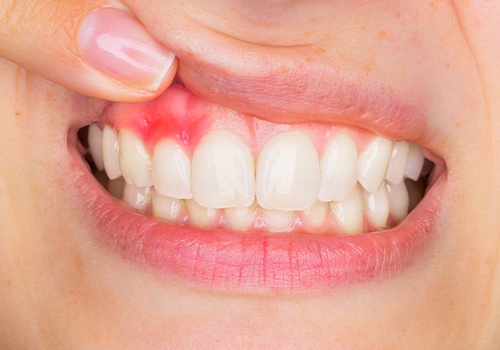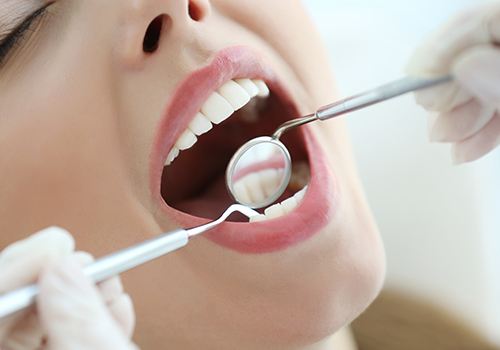Periodontal Therapy – Kerrville, TX
Give Your
Teeth a
Healthy Home
More Americans lose teeth to periodontal disease every year than they do to decay and cavities. We can increase your chances of keeping your teeth by slowing the advancement of gum disease, restoring health and strength to your teeth, gums, and underlying jawbone with different periodontal therapy in Kerrville, TX. Periodontal treatment at our family dental office in Kerrville can successfully treat gum disease and halt its progression, safeguarding your teeth and ensuring a long-lasting smile.

Why Choose Carroll R. Butler, DDS Family Dentistry for Periodontal Therapy?
- Amoxicillin and Metronidazole Antibiotic Therapy Available
- Laser-Assisted Technology to Preserve Healthy Tissue
- Multiple Sedation Options Provided In-House
What is
Gum Disease?

Gum disease is technically an infection of the gum tissue. It can appear in varying severities, all of which require treatment to address. When the gum tissue is attacked by plaque acids produced by bacteria, it irritates the tissue and causes it to become inflamed. Without treatment, this infection can spread to all areas of the gum tissue, resulting in tender and sensitive gums, bleeding while brushing or chewing food, gum recession, and even permanent tooth loss.
Gum disease continues to be one of the most common chronic diseases in the world, but that doesn’t mean it can’t be treated. When caught in the early stages, it can even be completely reversed. Furthermore, even more advanced stages of gum disease can be managed with personalized care from our dental office.
What Are the Symptoms of
Gum Disease?

One of the biggest concerns of gum disease is that the symptoms are not largely present until it’s already done damage to gum tissue. However, there are a few signs you can keep an eye out for. The American Academy of Periodontology notes to be on the lookout for:
- Red, dark purple, swollen or tender gums
- Bleeding while brushing, flossing, or eating hard food
- Receding gum tissue (causing teeth to appear longer than normal)
- Sores in your mouth
- Chronic bad breath that does not go away (even after brushing)
- Changes in the way your teeth fit together
- Changes in how your denture fits (if applicable)
- Pus forming between your gums and teeth
In the early stages of gum disease, also known as gingivitis, you may notice bleeding after you floss. However, this is likely a sign that you are not flossing enough and should go away on its own if you continue to floss regularly. However, if bleeding continues despite improving your oral care, call our dental office.
How is
Gum Disease
Treated?

There are multiple solutions for treating gum disease. If gingivitis is present, improved at-home care and a detailed cleaning at our dental office should be enough to reverse your condition. In the more advanced stages of gum disease (such as periodontitis), scaling and root planing, antibiotic therapy, and laser-assisted new attachment procedure (LANAP) are performed.
Scaling & Root Planing
Scaling and root planing is the most common and conservative form of treatment for gum disease. Scaling is the removal of calculus (commonly called tartar) and plaque that attach themselves to the tooth surfaces. The process especially targets the area below the gum line and along the root. Plaque is more likely to stick to rough surfaces. For this reason, scaling is followed by root planing, which removes any remaining calculus and smooths irregular areas of the root surface.
Learn More About Scaling and Root Planing
Antibiotic Therapy
Following your gum therapy, we need to make sure that your gums begin healing as soon as possible. That’s why we offer Amoxicillin and Metronidazole antibiotics specifically for treating gum disease. Amoxicillin is designed to prevent microbes from multiplying and surviving. Metronidazole is more intended for those dealing with severe periodontitis and partners very well with Amoxicillin. When you come back for your follow-up appointment (which generally occurs every three to four months), we’ll confirm that the antibiotics are working as intended.
Laser-Assisted New Attachment Procedure (LANAP)
The Laser-Assisted New Attachment Procedure (LANAP) is a gum surgery designed to treat more advanced periodontitis. Local anesthesia is administered, and a short-duration laser pulse is used on the pockets around the patient’s afflicted teeth, which are probed to a depth of about a quarter of an inch. This destroys bacteria and pathologic proteins near the root; the connective tissue is preserved, while infected tissue is destroyed. Typically, two or three passes with the laser clears the infected pocket.

